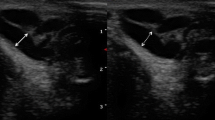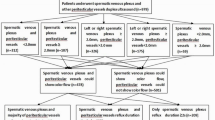Abstract
Varicocele is the most important male factor responsible for decreased fertility potential in married couples. From March through June 1994, 2,470 school boys aged 10–20 years were examined to establish the incidence of consecutive grades of varicocele and to develop a protocol for diagnosis and treatment of adolescents with varicocele. Grade 1 varicocele was found in 18%, grade 2 in 12%, and grade 3 in 5% of the population examined. An original protocol of ultrasonographic (US) examination (previously verified by angioscintigraphy) was introduced to assess boys with clinically diagnosed varicocele. The volume of each testis, testicular volume decrease (TVD), pampiniform vein diameter (PVD), and basal (BBF) and maximum blood flow (MBF) velocities were measured in 625 boys. In 74 cases a semen analysis was performed. The statistical analysis revealed that the presence of venous reflux and PVD correlated with the grade of varicocele. Decreases in testicular volume were highly dependent on the grade of varicocele, PVD, and BBF and MBF velocities. Analysis of the relationship between spermatic (boys over 17 years) and US findings revealed that the quality of spermatogenesis can be predicted by US examination in adolescents with varicocele. The authors recommend multiparametric US examination as a reliable, objective, and repeatable technique for establishing criteria for operative treatment in boys under 18 years of age with varicocele as well as for postoperative evaluation.
Similar content being viewed by others
References
Thompson ST (1994) Prevention of male infertility: an update. Urol Clin North Am 21(3): 365–376
Honig SC, Thompson S, Lipschultz LI (1993) Reassessment of male-factor infertility, including the varicocele, sperm penetration assay, semen analysis, and in vitro fertilization., Curr Opin Obstet Gynecol 5: 245–251
World Health Organisation (1992) The influence of varicocele on parameters of fertility in a large group of men presenting to infertility clinics. Fertil Steril 57(6): 1289–1293
Chehval MJ, Purcell MH (1992) Deterioration of semen parameters over time in men with untreated varicocele: evidence of progressive testicular damage. Fertil Steril 57: 174–177
Schlesinger MH, Wilets IF, Nagler HM (1994) Treatment outcome after varicocelectomy. A critical analysis. Urol Clin North Am 21(3): 517–529
Lyon RP, Marshall S, Scott MP (1982) Varicocele in childhood and adolescence: implication in adulthood infertility? Urology 6: 641–644
Pozza D, D'Ottavio G, Masci P, et al (1983) Left varicocele at puberty. Urology 3: 271–275
Castro-Magana M, Angulo MA, Canas A, et al (1989) Improvement of Leydig cell function in male adolescents after varicocelectomy. J Pediatr 115: 809–812
Hadziselimovic F, Herzog B, Liebundgut B, et al (1989) Testicular and vascular changes in children and adults with varicocele. J Urol 142: 583–585
Steeno O, Knops J, Declerck L, et al (1976) Prevention of fertility disorders by detection and treatment of varicocele at school and college age. Andrologia 8: 47–53
Kass EJ (1990) Evaluation and management of the adolescent with a varicocele. AUA Update Series, vol. IX, pp 90–95
Nagar H, Levran R (1993) Impact of active case finding on the diagnosis and therapy of pediatric varicocele. Surg Gynecol Obstet 176: 38–40
Dubin L, Amelar RD (1970) Varicocele size and results of varicocelectomy in selected subfertile men with varicocele. Fertil Steril 21: 606–609
Paduch D, Niedzielski J, Raczynski P (1995) Could CW Doppler replace angioscintigraphy in assessment of adolescent varicocele? Presented at the 1st European Congress of Paediatric Surgeons, Graz, Austria, May 1995, abstract 283
Laven JSE, Haans LCF, Mali WPThM, et al (1992) Effects of varicocele treatment in adolescents: a randomized study. Fertil Steril 58(4): 756–762
Hienz HA, Voggenthaler J, Weissbach L (1980) Histological findings in testes with varicocele during childhood and their therapeutic consequences. Eur J Pediatr 133: 139–146
Kass EJ, Chandra RS, Belman AB (1987) Testicular histology in the adolescent with a varicocele. Pediatrics 79(6): 996–998
Oster J (1971) Varicocele in children and adolescents. Scand J Urol Nephrol 5: 27–32
Author information
Authors and Affiliations
Rights and permissions
About this article
Cite this article
Niedzielski, J., Paduch, D. & Raczynski, P. Assessment of adolescent varicocele. Pediatr Surg Int 12, 410–413 (1997). https://doi.org/10.1007/BF01076952
Accepted:
Issue Date:
DOI: https://doi.org/10.1007/BF01076952




